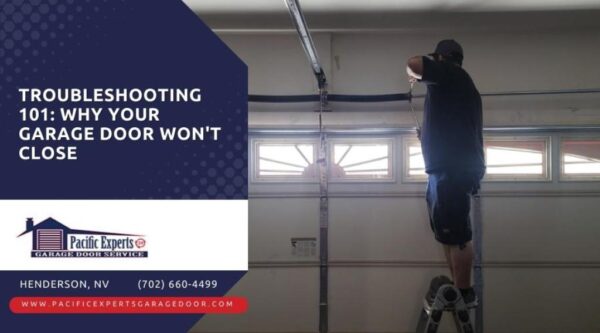Have you ever been in a rush only to find that your garage door won't close? It's a common garage door issue many homeowners face. In this guide, we'll dive deep into the reasons behind this problem and provide actionable solutions. Whether it's a misaligned track or a transmitter battery issue, we've got you covered. Let's get started!
- Understanding the Basics
- Common Reasons Why Garage Doors Don't Close
- Advanced Troubleshooting Tips
- Maintenance Tips for Prolonged Garage Door Life
- Pacific Experts: Secure Your Garage Door's Best Performance
- Frequently Asked Questions
- How do I realign my garage door sensors?
- Can a power outage affect my garage door's functionality?
- How often should I replace the batteries in my garage door transmitter?
- What safety precautions should I take when inspecting my garage door?
- Are there any DIY solutions for a misaligned track?
Understanding the Basics
Every garage door, whether manual or automatic, is a marvel of engineering. At its core, a garage door is a balance of mechanical and electronic components working in harmony. The transmitters are like the brain, sending signals to instruct the door. They communicate with the sensors, and the eyes of the system, ensuring everything is safe for the door to move. The mechanical parts, such as springs, tracks, and rollers, are the muscles, doing the physical work. Understanding these components is crucial. It's like knowing the ABCs before diving into literature. With this foundation, troubleshooting becomes a systematic process, making it easier to pinpoint and address issues.
Common Reasons Why Garage Doors Don't Close
Before we delve into the specifics, it's essential to grasp the bigger picture. A garage door might seem simple, but it's a complex system. Various elements must work in tandem for smooth operation. When one part fails or malfunctions, it can throw the entire system off balance. Let's explore the most common culprits behind a garage door that refuses to close.
- Transmitter Batteries: Imagine trying to watch TV with a dead remote battery. The same principle applies here. The transmitter requires power to communicate with the garage door. If the batteries are dead, the signal is lost. Regularly checking and replacing batteries ensures consistent communication and smooth door operation.
- Photo Eye Misalignment: These tiny devices play a massive role in safety. Positioned on either side of the door, they detect obstructions using an infrared beam. If something breaks this beam or if the eyes aren't aligned, the door won't close. Regular maintenance and gentle cleaning can prevent misalignment and blockages.
- Track Misalignment: Think of tracks as the rails guiding a train. If they're bent or out of position, the train derails. Similarly, a garage door can't move smoothly on misaligned tracks. Regular inspections can spot issues, and while minor adjustments can be DIYed, significant problems might require professional intervention.
- Transmitter and Opener Issues: Sometimes, the problem isn't with the door but with the device controlling it. Ensure the transmitter is within range and that the opener has power.
- Broken Springs: These do the heavy lifting. If they snap, the door won't rise. Regular inspections can help spot wear and tear before a break occurs.
- Limit Settings: Think of this as the door's understanding of up and down. Incorrect settings can make it stop short or not close fully. Adjusting the settings can resolve this.
- Disconnect Switch: This manual override disconnects the door from the motor. If engaged, the motor might run, but the door won't move.
- Obstructions: Always keep the door's path clear. Even small objects can interfere with the sensors.
- Locked Door: Some older models have manual locks. Ensure they're disengaged before using the automatic opener.
- Tension Springs and Cables: These assist the main springs. If they break, the door might fall suddenly. Regular checks can prevent such accidents.
Advanced Troubleshooting Tips
While the common issues are often easy to spot and fix, some problems lurk beneath the surface. Advanced troubleshooting dives deeper into the system. Maybe the infrared beam in the sensor is malfunctioning, or perhaps the motor unit has internal damage. These aren't always visible to the naked eye. Using specialized tools or seeking a professional garage door company's advice can be beneficial. Remember, while DIY solutions are great, there's no harm in calling in the experts when things get too technical.
Maintenance Tips for Prolonged Garage Door Life
A stitch in time saves nine, and this couldn't be truer for garage doors. Regular garage door maintenance can prevent most issues. Here are some tips:
- Lubrication: Like any machine, your garage door needs lubrication. Use white lithium grease or silicone-based lubricants on the tracks, rollers, and hinges every six months.
- Cleaning: Dust and debris can accumulate, especially on the tracks and sensors. A monthly cleaning can prevent many issues.
- Inspection: Take a few minutes each month to inspect the door, tracks, springs, and cables. Look for signs of wear and tear.
- Test the Balance: Disconnect the opener and manually lift the door halfway. If it doesn't stay put, the springs might need adjustment.
Pacific Experts: Secure Your Garage Door's Best Performance
Your garage door is more than just an entrance; it's a security feature, an investment, and a reflection of your home's curb appeal. Ensuring its optimal performance is crucial. At Pacific Experts, we understand this. With years of experience, cutting-edge tools, and a team of dedicated professionals, we ensure your garage door is always in top shape. Whether it's regular maintenance, advanced troubleshooting, or an emergency fix, trust Pacific Experts in Henderson, NV to deliver.
Frequently Asked Questions
How do I realign my garage door sensors?
Garage door sensors are crucial for safety. If misaligned, they can prevent the door from closing. To realign them, first, ensure there's no obstruction. Then, gently adjust the sensors by hand until their indicator lights are stable. Regular checks can prevent misalignment, ensuring smooth operation.
Can a power outage affect my garage door's functionality?
Absolutely! Power outages can disrupt the operation of automatic garage doors. However, most modern doors come with a manual override. This feature allows you to operate the door manually during outages. Once power is restored, you can switch back to automatic mode.
How often should I replace the batteries in my garage door transmitter?
Batteries are the lifeblood of your transmitter. Over time, they can deplete, leading to weak signals or no function at all. As a rule of thumb, replace the batteries once a year or when you notice a lag in response.
What safety precautions should I take when inspecting my garage door?
Safety first! Always disconnect the power before inspecting. Wear gloves and safety glasses, and avoid placing hands near moving parts. If you're unsure about something, it's always best to consult with garage door professionals near you.
Are there any DIY solutions for a misaligned track?
Yes, minor misalignments can be fixed at home. Use a level to check the alignment and adjust the tracks with a rubber mallet. However, for significant issues, it's best to call in experts.



